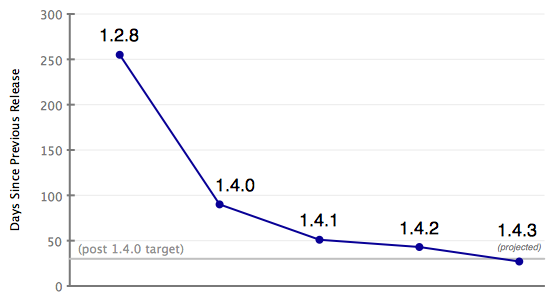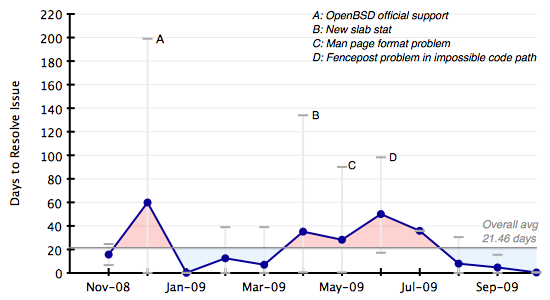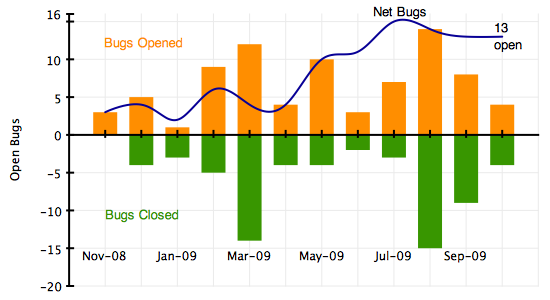Memcached - Report Card for an Open Source Project
While approaching our 1.4 release, the memcached project slipped into a state where we weren’t pushing out new code very frequently.
Some members of the community demanded releases occur more frequently, so dormando published a proposal for a release cycle for memcached that would help drive us into the direction of universal happiness.
I had a feeling that his plan and efforts to keep us on it were quite effective, but the purpose of this post is to sort of take an objective retrospective look and see how the reality of the progress of the project holds up to my perception.
Release Scheduling

This chart pretty much speaks for itself. It’s clear to see that we very quickly approached the stated goal of 30 days between releases.
I should note that 1.4.1 was released later than expected because a user hit a real live failure scenario in a production system that took a while to isolate. Once we did, we wrote some tests to ensure that the entire class of bug described can’t happen again.
These releases are bigger than they appear, but very well tested on our build farm and in production environments. To see what goes into each release, check the release notes for 1.4.0, 1.4.1, and 1.4.2.
Bug Status
We’ve been taking bugs very seriously.
Crash bugs are resolved very quickly, but bugs in general are resolved within our release cycle.
Please let us know via our mailing list or our bug tracker if you’re having issues or can’t figure something out. We fix things very quickly, but we can’t fix what we don’t hear about. Remember that goes for the wiki docs, too.
The following chart shows the average age (time between when they were filed and when they were closed) of bugs by month in memcached. The error bars are showing the minimum and maximum age for any given month. Issues marked as invalid, won’tfix, and had other indicators of not being actual defects or missing features in the software were excluded.
Four anomalies were identified and described briefly in the chart. These are all considered trivial issues that were not detrimental to the state of the server, but they do show that we’re sometimes not too quick in cases like these. (more details on A, B, C, and D).

I also found it useful to consider what I called the “bug load.” That is, the number of bugs going in and out of the project by month.
The following chart is showing bugs activity in the memcached project.
Positive numbers are bugs being reported to the project. Negative numbers are bugs that we closed (bugs removed from the project). The line indicates the net number of bugs at the end of the given month.

So What’s the Grade?
I’d say we’ve got a solid B. We have room for improvement and I’m confident we’re making it.
If you disagree (and can articulate why specifically) or otherwise have feedback, a warm, active community awaits.
Contact us on irc (freenode.net #memcached), email suggestions or questions to our list, or just go file a bug.
